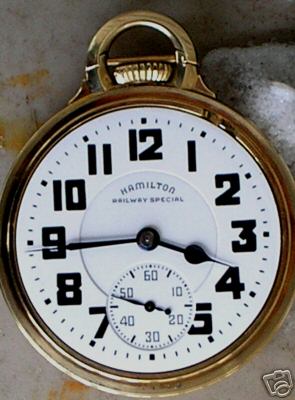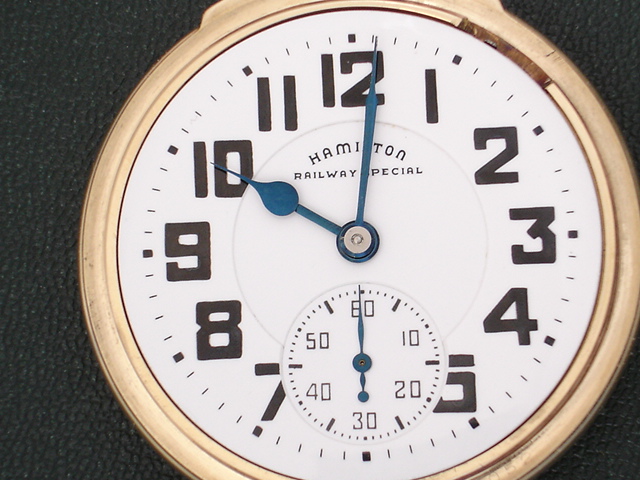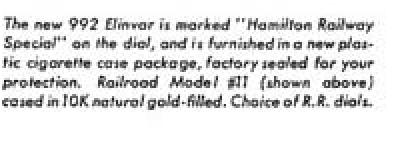
| WWT Shows | CLICK TO: Join and Support Internet Horology Club 185™ | IHC185™ Forums |

|
• Check Out Our... • • TWO Book Offer! • |
Welcome Aboard IHC185™  Internet Horology Club 185
Internet Horology Club 185  IHC185™ Discussion Site Main Page
IHC185™ Discussion Site Main Page  Open to the World RESEARCH FORUMS
Open to the World RESEARCH FORUMS  Hamilton and 992B Research Forum
Hamilton and 992B Research Forum  Did the 536 dial change, or did we miss one?
Did the 536 dial change, or did we miss one?
 Internet Horology Club 185
Internet Horology Club 185  IHC185™ Discussion Site Main Page
IHC185™ Discussion Site Main Page  Open to the World RESEARCH FORUMS
Open to the World RESEARCH FORUMS  Hamilton and 992B Research Forum
Hamilton and 992B Research Forum  Did the 536 dial change, or did we miss one?
Did the 536 dial change, or did we miss one?Go  | New Topic  | Find-Or-Search  | Notify  | Tools  | Reply to Post  |  |
From what little information I have, Hamilton only made one Double-sunk, Porcelain HG RWS Dial, that being the 536. But I've recently found reason to suggest there may be another that may not be documented. Or that it changed. Below we have a piece of a page from a 1950 catalogue. As near as I can tell they are both Double-sunk, and both Porcelain dials, (based on the sharper, un-chamfered corners on the 2 and 8, that are characteristic of the melamine dials). Now notice the difference in the thickness of the numerals. Then below that in the two posts following I have included pictures of two actual watches, both of which have double-sunk, porcelain dials. And they seem to indicate that Hamilton either changed the dial over time (but not much time), or they are different dials altogether. What is truly strange is that both appear to be pictured in the 1950 catalogue, with the one being a much heavier gothic than the other. The dials in the pictures of the two real watches also seem to verify that the images in the catalogue page could in fact be two porcelain dials.  | |||
|
Extra-HG ???  | ||||
|
HG ???  | ||||
|
I have seen variations in the thickness of the hour markers on these and other dial examples.... in Hamilton and also other manufacturer's dials. this, IMHO, is attributed to manufacturing variances of the template for the number application during the dial making process. Some variation can also be attributed to 'fresh ink' vs 'depleted ink' during the production run... (is this something understandable?) I don't think that makes for an entirely different dial...... One thing to consider in the 1950 ad..... the image on the left could be 'old' artwork developed a few years before the melamine introduction, and the one on the right is an actual melamine dial....... Remember this also... the model 14 was developed as a 'low cost' watch.... so i doubt very seriously if this dial shown is an enamel dial. And with this time frame, I do not think the actual watch one would receive if the left one was ordered would have an enamel dial... (also note the 'clipped' 10 in the lower dial . | ||||
|
Assuming you are right Terry, this wouldn't be the first time we've seen and discussed the "inaccuracies" of images in the ads that Hamilton used. Given the company's apparent habitual use of old art, or even artistic license in their advertisements, it would seem that the only sure way to obtain absolute proof of what was available (and in what form), would be a combination of the box labels and their contents in the rare instances when both are available, and one can reasonably assume the watch is all original. So, if the ads are inaccurate, it seems we can only rely on what we find in order to absoulutely determine what once was available. I'm not trying to say my original supposition is right or wrong based on this, but rather as it might be applied in a more general sense. In other words, something I might have could be "right", at least until proven wrong with more than what the images in the ads provide, by themselves. An example might be a late-fifties 992B in a Model 15 case that happens to have an enamel dial on it. I don't have one of these, and would doubt its authenticity if I did, but I can't say for a fact that it could not be original. That's the downside to trying to use the ads as absolute proof of what was and what wasn't, when they aren't accurate to start with. Is this something understandable? Also, in the blueprints of each, Hamilton described the 024 dial as Heavy Arabic and the 081 dial as Extra Heavy Arabic, but in the 1947 Material Catalogue these same dials are listed as HA (024), and BM (081). Because of this I believe there's always the outside chance that they produced two distinct versions of the HG dial, but failed to describe them as such in their literature, or possibly they simply failed to include an entry for one of them. Who can say for sure, especially when we do see such inconsistencies in their descriptions, and the use of old (apparently incorrect) images over and over again in their advertisements? I think it is possible, though admittedly I have no understanding of the actual production processes involved so I can't speak to template variances, or the results or consequences of using fresh ink vs. depleted ink. Something that keeps coming back to me is the inner box with the HA label I have and what the company actually put in that box. All we know for sure right now is that we don't know what it was. And it is unlikely that it is the only unsolved mystery waiting to be figured out, or so I would think... In a former life I may have been put to death for trying to convince Shirley McClain (then known as Queen Isabella) that the earth was not flat just before that bloody upstart, Chris Columbus, persuaded her to finance his own attempt to sail to the edge of the world.... | ||||
|
U betcha........ That is why I refer to Box Labels and why I have studied them..... and hundreds of watches themselves..... hands on.... no substitute there. And then the records (good or bad) from the company. The internal memo on Melamine dials is dated 1946, this pre-dates the 1950 catalog... The HG enamel dial became the 121 dial when the change to Melamine occurred.... and the 168 dial was the single sunk Melamine version..... both with HG characters.... You will see 121 and 168, and 379 as dial numbers on the labels in the later watches.... One apparent thing is ..... Marketing, Engineering, and Material divisions do not seem to speak the same language ... and yep, the Identity of the HA is still 'out there'...... on a side note.. I can show you variations in boldness of the BM Numerical dials... to me, this don't mean they are different dials... . | ||||
|
If I had to make a choice on this one, I'd side with you. But I said what I said mostly to articulate (in my own head) why it is likely not a good thing to jump to conclusions.
Sometimes I don't think they were even on the same page, literally Yes the melamine was "introduced" in '46. But production problems (and most likely a ready supply of porcelain leftovers), kept them from being all that was available until well into the fifties. Don's research has shown this, as has Hamilton's own statements, and our own discoveries. If they had it, you could buy it....  | ||||
|
| Powered by Social Strata |
| Your request is being processed... |
|
Welcome Aboard IHC185™  Internet Horology Club 185
Internet Horology Club 185  IHC185™ Discussion Site Main Page
IHC185™ Discussion Site Main Page  Open to the World RESEARCH FORUMS
Open to the World RESEARCH FORUMS  Hamilton and 992B Research Forum
Hamilton and 992B Research Forum  Did the 536 dial change, or did we miss one?
Did the 536 dial change, or did we miss one?
 Internet Horology Club 185
Internet Horology Club 185  IHC185™ Discussion Site Main Page
IHC185™ Discussion Site Main Page  Open to the World RESEARCH FORUMS
Open to the World RESEARCH FORUMS  Hamilton and 992B Research Forum
Hamilton and 992B Research Forum  Did the 536 dial change, or did we miss one?
Did the 536 dial change, or did we miss one?©2002-2025 Internet Horology Club 185™ - Lindell V. Riddle President - All Rights Reserved Worldwide

